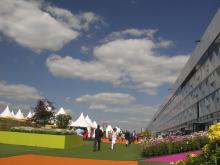Champagne, Sake, South West France and Victoria's Secret
POSTED ON 25/06/2009I'm at Vinexpo this week for the big Bordeaux wine fair, more of which in due course.
 Vinexpo
Vinexpo
Meanwhile, in this week's journal, aka blog, I get narrow-minded with a piece in The World of Fine Wine (Issue 24, 2009) on single vineyard and single village Champagnes, along with a tasting of some great examples of the style. It’s an extraordinary subject not least because the whole idea of individual vineyard champagnes defies the peculiarly champenois notion that the best champagnes are blends of different vineyards and regions. And yet, it’s a growing trend whose time has clearly come, as you’ll find out, if you read more, on:
http://www.anthonyrosewine.com/article/world-fine-wine/monoparcel-champagne
Last week, Philip Harper came to town and showed some of his sakes at Bincho in Old Compton Street. Philip is Japan's only toji, or sake master brewer, and he specialises in creating premium sakes in Osaka, some of which are downright weird and require even more of an acquired taste than sakes generally.
 Philip Harper, toji
Philip Harper, toji
One of Philip's big things is the right temperature for serving sake. Dismissing the notion that serving sake warm is just for tourists and people who don't know anything about sake, he served a number of different sakes, each in groups of three, chilled, room temperature and warm. What came across for me was the fact that while I preferred the more delicate and aromatic styles such as ginjo and daiginjo chilled, I could see that some of the funkier and more basic styles were very good warm. Clearly I need much more practice at this, so will do my best to try out as many styles at as many temperatures as I can.
South-West France: Ancient and Modern
This is part 2, the Gascony side, of the seminar I gave on the wines of South West France at this year’s London International Wine Fair. In case you missed it, published part 1 a couple of weeks ago: http://www.anthonyrosewine.com/journal/2009/6/south-west-france-ancient-....
If you want to avoid reading all this and prefer to hear me burbling on about the subject, Green Shoots’ Huw Price did a podcast with me just after the seminar and you can find it by pasting into your browser: http://www.green-shoot.com/podcast/green-shoot_huwprycetalks_anthonyrose....
Here we go then, the Wines of South West France, part 2, the Gascon Connection
Saint Mont
2005 Monastère de Saint Mont, Plaimont, VDQS Saint Mont
Saint Mont - Home of tannat, fer servadou (pinenc)
Appellation located in the Gers département.
•Surface: 1,100 ha
•Production: 60,000 hl
•98% of volume produced by one cooperative, 3% by producers
•Grapes:
Red wines: Tannat 60 % minimum, Fer Servadou (Pinenc) 20% minimum, 20 % maximum Cabernet Sauvignon or Franc .
White wines : Arrufiac 20 % minimum, Petit Courbu 20 % minimum, Gros and Petit Manseng 60 % maximum.
A northerly extension of the Madiran vineyard, Saint-Mont was granted VDQS status in 1981. 50% red, 30% rosé and 20% white. The appellation is dominated by the superb Plaimont co-operative. Reds, from Tannat with Fer (Pinenc), and the Cabernets are often vividly fruity; dry whites from Courbu and Arrufiac with the two Mansengs are crisp, aromatic and fine value for money, as are the modern fruity rosés.
In the Gers in the heart of Saint Mont village, the 2005 Monastère de Saint Mont, Plaimont, VDQS Saint Mont, £13.99, Bedales, is a blend of 70% tannat, 20% pinenc and 10% cabernet.
Deep-coloured, lovely richness of fruit, good sweet core of dark fruits with undertones of bittersweet chocolate, this is a ripe and satisfying blend, with nice succulent tannins, touches of spicy oak and good balancing savoury acidity. Overall, a very satisfying mouthful of fruit and the best of the Saint Monts, which seem to be an almost exclusive Plaimont preserve.
Madiran
2007 Chateau d’Arricau-Bordes, Cave de Crouseilles.
Home of Tannat
Appellation over 3 départements: Hautes-Pyrénées, Gers and Pyrénées-Atlantiques
•Surface: 1,300 ha
•Production: 70,000 hl
•3 cooperatives represent 50% of production and 55 independent producers
•Grapes: Tannat 60 %, Cabernet Franc 31%, Cabernet Sauvignon 8 %, Fer Servadou (Pinenc): less than 1 %.
55 hl / ha
The appellation, granted in 1975 for red wine only, is situated mainly to the north-east of Pau, but a second area is roughly coterminous with Jurançon. Clay-limestone is the most common soil type. The climate is oceanic climate and the vineyards affected by proximity to the Pyrenees. Tannat is the dominant variety, but both Cabernets and Fer are also planted. The wines are robust, tannic and long-lived. The best are very fine indeed and well repay cellaring. Innovative winemaking is also now used to produce a softer, more immediately fruity style of Madiran.
2007 Chateau d’Arricau-Bordes, Cave de Crouseilles, a blend of 70% tannat, 20% cabernet sauvignon and 10% cabernet franc, £14.99, The General Wine Company.
Deep-coloured and vivid, this shows some coffee-bean spicy oak on the nose and a youthful, vibrant, almost fierce quality of brambly, damson and mulberry fruit underscored by spiciness with supple tannins and a vivid damsony bite of acidity. Muscular, youthful and well-balanced, showing perhaps a little too much oak at the moment, its balance of acidity and tannins suggest it will settle into a very nice wine in a year or so. This is what tannat is all about.
Irouléguy
2007 Domaine Arretxea, Irouléguy
Irouléguy - Home of tannat and Bordeaux varietise
AC in the heart of the Basque Country in Pyrénées-Atlantiques département.
•Surface: 215 ha
•Production: 7,500 hl
•10 producers including 1 cave coopérative.
•Grapes:
Red wines : Tannat (50%), Cabernet Franc (25%), Cabernet Sauvignon (25%).
White wines : Gros Manseng (60%), Petit Manseng (30%), Petit Courbu (10%).
Irouléguy’s problem is not that it doesn’t make good wine but that it sounds a bit like a bowl problem. Feeling bit Irouléguy? No sweat, take fer servadou three times a day and it’ll soon sort the problem.
Much of the 200 ha or so of this AOC (granted in 1970) in the heart of the Basque country is planted on spectacularly steep, sunny, south-facing terraced vineyards. Gutsy reds and delicate rosé wines are made from tannat with the two cabernets; fragrant dry whites are blended from courbu and the two mansengs, petit and gros.
An appellation consisting of nine communes, Irouléguy is situated in the French Basque country high up in the Pyrenees on the border with Spain. These wines are grown on the last remnants of a big Basque vineyard founded in the 11th century by the monks of Ronçevaux Abbey. Vines are grown on steep terraces and are be harvested by hand. Most production is red or rosé.
2007 Domaine Arretxea, Irouléguy, a blend of 50% tannat, 30% cabernet franc, 20% cabernet sauvignon, around £14.77, Les Caves de Pyrène, Zélas.
From Thérèse et Michel Riouspeyrous, this has good vivid colour and freshness on the nose, with no oak and well-made vivid red berry fruits (plums and black cherries and a hint of cranberry on the nose). More black fruit and pleasant leathery notes on the palate with subtle tannins. Bold, earthy and rustic, refreshing acidity and good supple textured fruit, a refreshing contrast, literally, to the more obviously overoaked styles.
And Finally: Victoria’s Secret
Remember when Victoria Beckham made an appearance in the papers drinking red wine and clad in nothing but bra, black knickers and suspender belt? Possibly not, but nothing new I think you’ll agree for the queen of overexposure, except perhaps the red wine.
Now I wouldn’t want you to think that I have an interest, healthy or otherwise, in Victoria Beckham’s lingerie or for that matter what goes on behind closed doors at Beckingham Palace. Heaven forfend.
I was amazed though by the revelation that a judge had ruled against their bid to win an injunction against The News of the World to prevent a former nanny, the obnoxious Abbie Gibson, from revealing marital secrets gained in confidence. Apparently the judge in his wisdom, and our judges are nothing if not wise, had ruled that the story was in the public interest.
Come again Mr Justice Langley? Do you sit in the dentist’s waiting room reading Hello and deem intrusion into Posh and Becks’ private life to be so important that the details need to be made public? On that basis, we should all be told the intimate circumstances of Mr Justice Langley’s own private life. On second thoughts, yawn, spare us the boredom.
Publicity seekers Posh and Becks may be, but that doesn’t mean that they don't have the right to wash their dirty linen out of the public gaze.
It was gratifying at least to see that the money-grubbing nanny had been forced to make a grovelling apology in the High Court after a four-year legal battle over the confidential information. Result, as our most famous first couple might have said.

